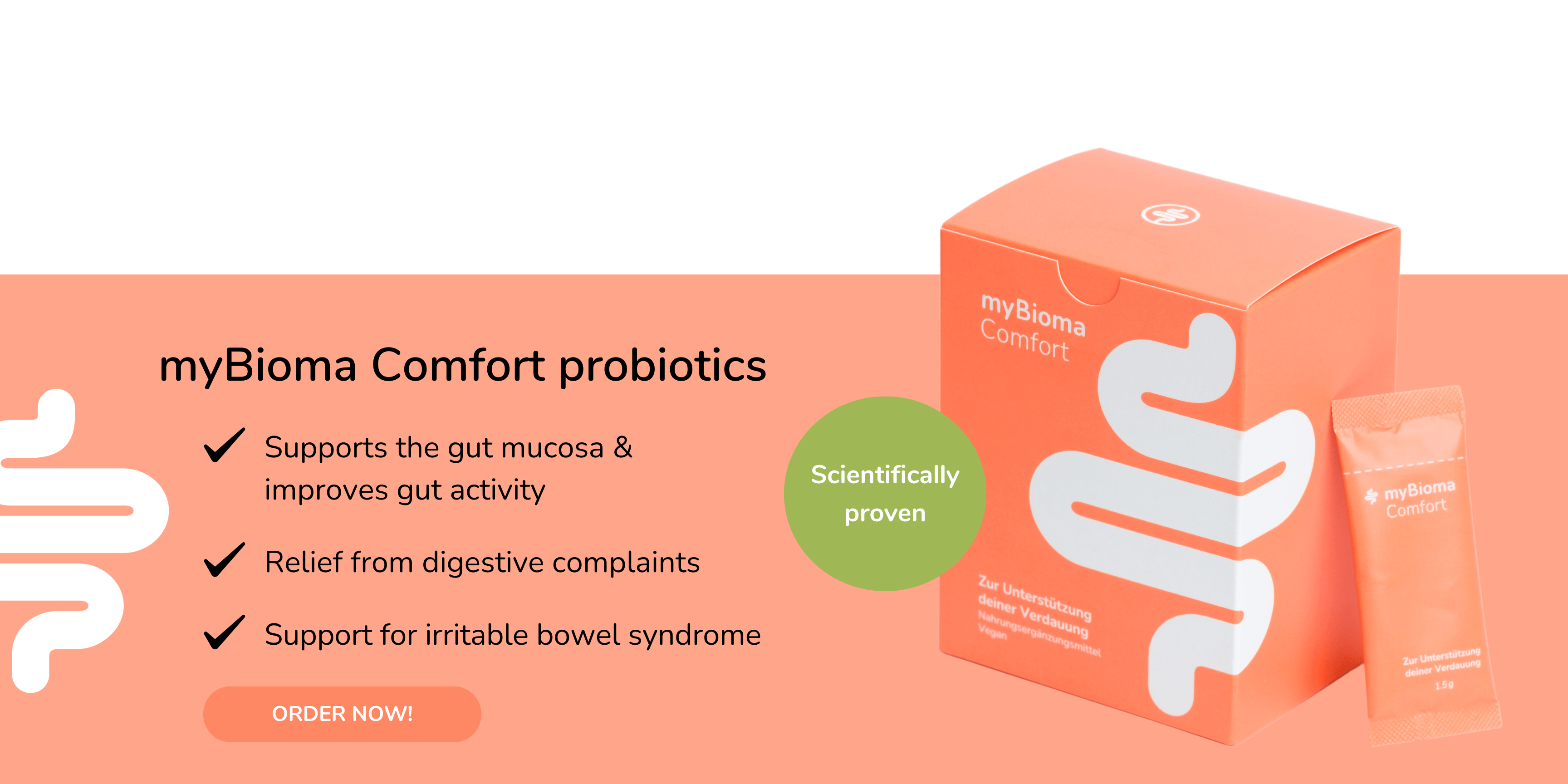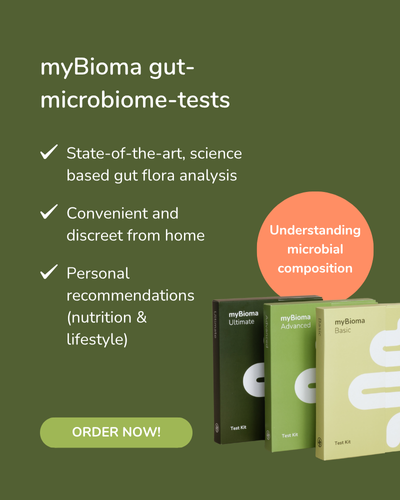Table of contents
- The connection between chronic inflammation, the aging process and the intestinal microbiome
- What defines the human aging process?
- What role does the gut microbiome play in age-related inflammation?
- A brief insight into the development of the intestinal microbiome
- Microbiome & aging processes
- How does the intestinal microbiome change in old people?
- Fecal transplants can improve brain health
- Prevention of age-related health conditions through the gut microbiome
- With myBioma to a healthy intestinal microbiome until old age
The connection between chronic inflammation, the aging process and the intestinal microbiome
As the population ages in industrialized nations worldwide, the need for healthcare solutions to reduce the burden of age-related diseases grows. The Prevention and treatment of chronic inflammation represents a particularly promising strategy considering that inflammation is observed in almost every age-related disease. Recent studies suggest that Gut microbiome could play a key role in age-related inflammation.
What defines the human aging process?
In humans, the aging process is a continuous and progressive process that results in reduced physiological function in all organ systems (1). These physiological decreases lead to increased susceptibility to infection and disease (2, 3). Although the causes of age-related diseases are diverse, there is significant evidence linking it to chronic inflammation (4).
What role does the gut microbiome play in age-related inflammation?
There are more and more assumptions that this Gut microbiome could play an essential role in these age-related inflammations. The latest studies suggest that advanced age is associated with... Changes in the composition of the intestinal microbiome is connected, which is connected by one Loss of diversity is marked (5). Diversity refers to the difference in the composition of the intestinal microbiome and shows whether the different types of bacteria occur evenly in the intestine or whether some types of bacteria dominate.
A brief insight into the development of the intestinal microbiome
Microbial colonization of the human intestine begins at birth and immediately thereafter. However, some studies suggest that the process of colonizing the infant with microorganisms begins in the womb (10-17). In any case, it is recognized that the basic microbiome composition during infancy, in particular during the first three years , continues to fluctuate widely until it eventually adapts to a stable structure that resembles the adult gut microbiome (10-18).

The type of birth already plays a role in the development of the intestinal microbiome.
What influences the development of the intestinal microbiome?
The Bacterial composition is influenced by various components , such as the infant's diet, antibiotic intake, the mother's diet, its intestinal microbiome and the environment (11, 12, 15-17, 19). It has also been reported that vaginally delivered infants have higher colonization of Lactobacilli, Bacteroides, and Prevotella, which are mostly acquired from maternal vaginal and fecal microbiota during birth. Infants born by cesarean section, on the other hand, have delayed or lower intake of Bacteroides, bifidobacteria and lactobacilli. (10, 12, 15-17, 19-20)
Microbiome & aging processes
The composition of the intestinal microbiome in adults is more stable than in children. Over time, an intestinal microbiome develops that can independently compensate for changes caused by influences such as stress or antibiotics. Nevertheless, the intestinal microbiome can be influenced to a certain extent, for example through diet and lifestyle.
The frequency of diseases associated with the intestinal microbiome tend to increase with increasing age (21, 22). Even if it remains unclear whether the changes in the intestinal microbiome are a cause or a consequence of the aging process, it turns out that that older people have a different gut microbiome profile compared to healthy adults . This difference could be due to various reasons, such as changes in lifestyle and dietary habits, reduced mobility, or medication use (18, 22-27).
How does the intestinal microbiome change in old people?
In general, the diversity of the gut microbiome and the number of bacteria such as Bacteroides, Bifidobacteria and Lactobacilli are found to be reduced (18). Whereas most bacteria that increase with age are known to stimulate inflammation (29). While it is still unknown whether this bacterial imbalance is a cause or a consequence of aging and inflammation, it is Balance the gut microbiome with a healthy aging process connected. Therefore, maintaining or restoring this balance could be beneficial for healthy human longevity. (21, 26, 28).
Given that the gut microbiome has a strong influence on numerous aspects of health and the Since a decrease in diversity is associated with various inflammatory conditions , it seems plausible to also look at one's own health from the perspective of the intestinal microbiome.
Fecal transplants can improve brain health
Learning and remembering decrease significantly with increasing age. This deterioration in learning and memory performance runs parallel to changes in the intestinal microbiome. John Cryan, a neuroscientist at University College Cork, and his colleagues recently published in the journal Nature aging illustrates that microbes transferred from young to old mice cause age-related changes in the immunity and the metabolism in Brain can turn back. The study suggests that the microbiome could be a suitable therapeutic target for treating age-related cognitive decline.
“If the microbiome plays a causal role in brain aging, then we should be able to take the microbiome from young animals, give it to old animals and reverse or mitigate some of the effects of aging.” – John Cryan.

One of the key factors that influence our intestinal microbiome is a varied and fiber-rich diet.
Prevention of age-related health conditions through the gut microbiome
A good starting point to our intestinal microbiome Providing preventative support and counteracting inflammatory processes is ensuring a healthy diet with whole grains, vegetables, legumes, fruit, nuts and seeds. One of the key factors that influence our intestinal microbiome is and remains diet. We know that properly “feeding” our intestinal bacteria with various fibers not only increases microbial diversity, but also increases the production of anti-inflammatory short-chain fatty acids (SCFAs) (30) and the number of bacteria that can produce inflammatory substances. can reduce. SCFAs have been shown to help intestinal cells prevent inflammation in the intestines (31). By the way, we are not only what we eat, but also what we can digest. Find out more about this Digestive potential of your gut microbiome .
“By better understanding the connections between diet, microbiome and health, we can understand how older people can maintain their microbiome and also help them directly by using pre- and probiotic strategies. “This would help us age better and maintain health and quality of life as we age without medication or surgery” . – Marina Ezcurra, Ph.D.
We are excited about further research in this area as we see the potential to make huge breakthroughs in improving the health and quality of life of older people.
With myBioma to a healthy intestinal microbiome until old age
The myBioma microbiome analysis allows you to find out what your microbial composition is like and which bacteria live in your intestines. You receive one Overall picture of your intestinal universe and meaningful insights into how your health is doing. Depending on your results, you will receive dietary recommendations, for example to optimize your diversity and species richness. Learn more!
References
- Franceschi C, Motta L, Motta M, Malaguarnera M, Capri M, Vasto S, Candore G, Caruso C, IMUSCE. The extreme longevity: the state of the art in Italy. Exp Gerontol. 2008;43(2):45–52.
- Troen BR. The biology of aging. Mt Sinai J Med. 2003;70(1):3–22.
- Candore G, Colonna-Romano G, Balistreri CR, Di Carlo D, Grimaldi MP, Listi F, Nuzzo D, Vasto S, Lio D, Caruso C. Biology of longevity: role of the innate immune system. Rejuvenation Res. 2006;9(1):143–8.
- Cevenini E, Caruso C, Candore G, Capri M, Nuzzo D, Duro G, Rizzo C, Colonna-Romano G, Lio D, Di Carlo D, Palmas MG, Scurti M, Pini E, Franceschi C, Vasto S. Age-related inflammation: the contribution of different organs, tissues and systems. How to face it for therapeutic approaches. Curr Pharm Des. 2010;16(6):609–18.
- Jeffery IB, Lynch DB, O’Toole PW. Composition and temporal stability of the gut microbiota in older persons. ISME J. 2016;10(1):170–82.
- Jimenez E, Fernandez L, Marin ML, Martin R, Odriozola JM, Nueno-Palop C, Narbad A, Olivares M, Xaus J, Rodriguez JM. Isolation of commensal bacteria from umbilical cord blood of healthy neonates born by caesarean section. Curr Microbiol. 2005;51(4):270–4.
- Oh KJ, Lee SE, Jung H, Kim G, Romero R, Yoon BH. Detection of urea plasmas by the polymerase chain reaction in the amniotic fluid of patients with cervical insufficiency. J Perinat Med. 2010;38:261–8. ´
- Aagaard K, Ma J, Antony KM, Ganu R, Petrosino J, Versalovic J. The placenta harbors a unique microbiome. Sci Transl Med. 2014;6(237):237–65.
- Collado MC, Rautava S, Aakko J, Isolauri E, Salminen S. Human gut colonisation may be initiated in utero by distinct microbial communities in the placenta and amniotic fluid. Sci Re. 2016;6(1):23129.
- Nagpal R, Tsuji H, Takahashi T, Kawashima K, Nagata S, Nomoto K, Yamashiro Y. Sensitive quantitative analysis of the meconium bacterial microbiota in healthy term infants born vaginally or by cesarean section. Front Microbiol. 2016a;7:1997.
- Nagpal R, Kurakawa T, Tsuji H, Takahashi T, Kawashima K, Nagata S, Nomoto K, Yamashiro Y. Dynamics of the gut Bifidobacterium microbiota during the first three years of life: A quantitative assessment. Sci Rep. 2017a;7(1):10097.
- Nagpal R, Tsuji H, Takahashi T, Kawashima K, Nagata S, Nomoto K, Yamashiro Y. Gut dysbiosis followingC-section instigates higher colonization of α-toxigenic and enterotoxigenic C. perfringens in infants. Benef Microbes. 2017b;8(3):353–65.
- Nagpal R, Tsuji H, Takahashi T, Nomoto K, Kawashima K, Nagata S, Yamashiro Y. Ontogenesis of the gut microbiota development in healthy fullterm vaginally-born breast-fed infants over the first 3 years of life: A quantitative bird’s-eye view. Front Microbiol. 2017c;8:1388.
- Palmer C, Bik EM, DiGiulio DB, Relman DA, Brown PO. Development of the human infant intestinal microbiota. PLoS Biol. 2007;5(7):e177.
- Tsuji H, Oozeer R, Matsuda K, Matsuki T, Ohta T, Nomoto K, Tanaka R, Kawashima M, Kawashima K, Nagata S, Yamashiro Y. Molecular monitoring of the development of intestinal microbiota in Japanese infants. Benef Microbes. 2012;3(2):113–25.
- Backhed F, Roswall J, Peng Y, Feng Q, Jia H, Kovatcheva-Datchary P, Li Y, Xia Y, Xie H, Zhong H, Khan MT, Zhang J, Li J, Xiao L, Al-Aama J, Zhang D, Lee YS, Kotowska D, Colding C, Tremaroli V, Yin Y, Bergman S, Xu X, Madsen L, Kristiansen K, Dahlgren J, Wang J. Dynamics and stabilization of the human gut microbiome during the first year of life. Cell Host Microbe. 2015;17(6):852.
- Bokulich NA, Chung J, Battaglia T, Henderson N, Jay M, Li H, D Lieber A, Wu F, Perez-Perez GI, Chen Y, Schweizer W, Zheng X, Contreras M, Dominguez-Bello MG, Blaser MJ. Antibiotics, birth mode, and diet shape microbiome maturation during early life. Sci Transl Med. 2016;8(343):343–82.
- Odamaki T, Kato K, Sugahara H, Hashikura N, Takahashi S, Xiao JZ, Abe F, Osawa R. Age-related changes in gut microbiota composition from newborn to centenarian: A cross-sectional study. BMC Microbiol. 2016;16(1):90.
- Penders J, Thijs C, Vink C, Stelma FF, Snijders B, Kummeling I, van den Brandt PA, Stobberingh EE. Factors influencing the composition of the intestinal microbiota in early infancy. Pediatrics. 2006;118(2):511–21.
- Gronlund MM, Lehtonen OP, Eerola E, Kero P. Fecal microflora in healthy infants born by different methods of delivery: Permanent changes in intestinal flora after cesarean delivery. J Ped Gastroenterol Nutr. 1999;28(1):19–25.
- Han B, Sivaramakrishnan P, Lin CCJ, Neve IAA, He J, Tay LWR, Sowa JN, Sizovs A, Du G, Wang J, Herman C, Wang MC. Microbial genetic composition tunes host longevity. Cell. 2017;169(13):1249–62.
- Bartosch S, Fite A, Macfarlane GT, McMurdo M. E.T. Characterization of bacterial communities in feces from healthy elderly volunteers and hospitalized elderly patients by using real-time PCR and effects of antibiotic treatment on the fecal microbiota. Appl Environ Microbiol. 2004;70(6):3575–81.
- Claesson MJ, Cusack S, O’Sullivan O, Greene-Diniz R, de Weerd H, Flannery E, Marchesi JR, Falush D, Dinan T, Fitzgerald G, Stanton C, van Sinderen D, O’Connor M, Harnedy N, O’Connor K, Henry C, O’Mahony D, Fitzgerald AP, Shanahan F, Twomey C, Hill C, Ross RP, O’Toole PW. Composition, variability, and temporal stability of the intestinal microbiota of the elderly. Proc Natl Acad Sci USA. 2011;15(108):4586–91.
- O’Toole PW, Jeffery IB. Gut microbiota and aging. Science. 2015;350(6265):1214–5.
- Claesson MJ, Jeffery IB, Conde S, Power SE, O’Connor EM, Cusack S, Harris HMB, Coakley M, Lakshminarayanan B, O’Sullivan O, Fitzgerald Gerald F, Deane J, O’Connor M, Harnedy N, O’Connor K, O’Mahony D, Sinderen Dv, Wallace M, Brennan L, Stanton C, Marchesi JR, Fitzgerald AP, Shanahan F, Hill C, Ross RP, O’Toole PW. Gut microbiota composition correlates with diet and health in the elderly. Nature. 2012;488(7410):178–84.
- Collino S, Montoliu I, Scherer M, Mari D, Salvioli S, Bucci L, Ostan R, Monti D, Biagi E, Brigidi P, Franceschi C, Rezzi S. Metabolic signatures of extreme longevity in northern Italian centenarians reveal a complex remodeling of lipids, amino acids, and gut microbiota metabolism. PLoS One. 2013;8(8):e56564.
- Mitchell EL, Davis AT, Brass K, Dendinger M, Barner R, Gharaibeh R, Fodor AA, Kavanagh K. Reduced intestinal motility, mucosal barrier function, and inflammation in aged monkeys. J Nutr Health Aging. 2017;21(4):354–61.
- Biagi E, Candela M, Turroni S, Garagnani P, Franceschi C, Brigidi P. Aging and gut microbes: Perspectives for health maintenance and longevity. Pharmacol Res. 2013;69(1):11–20.
- Pamer EG. Immune responses to commensal and environmental microbes. Nat Immunol. 2007;8(11):1173–8.
- Jefferson, A. & Adolphus, K. The Effects of Intact Cereal Grain Fibers, Including Wheat Bran on the Gut Microbiota Composition of Healthy Adults: A Systematic Review. Frontiers in Nutrition 6, 33 (2019).
- Corrêa-Oliveira R, Fachi JL, Vieira A, Sato FT, Vinolo MAR. Regulation of immune cell function by short-chain fatty acids.Clin Transl Immunologyl. 5: e73 (2016).









